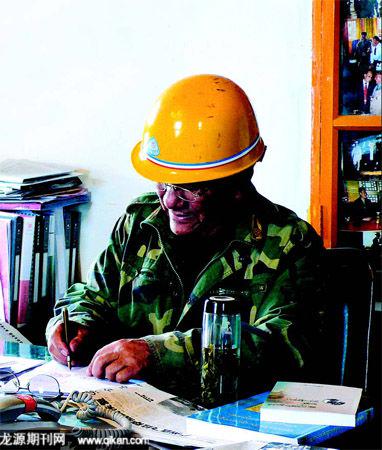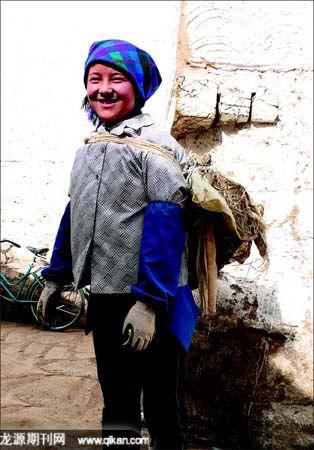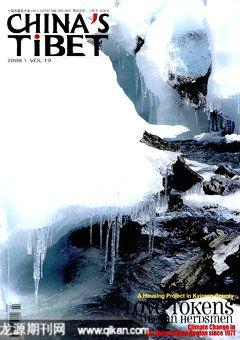Champa Kelzang:THE Warrior of the Potala Palace
Zhang Yuqian
When I met my husband, he frequently broughtup the name of Champa Kelzang, the director ofthe Administrative Department of the Potala Palace.He said: “I admire two persons in Tibet. One is theDirector-general of the Communication Bureau ofTibetan Autonomous Region, Mr. Gyatso(currentlyretired); the other is Mr. Champa Kelzang.”

In 2004, the clearance and renovation of the XoiArea, under the foot of the Potala Palace, waslaunched. All recently-built houses were to bedemolished in order to return the area to itsoriginal state before 1959. My husband was incharge of the decorative planting program for thisparticular area. He spent all his time at theconstruction sites. Last week, in my company, heclimbed up to the Palace for his work there.Frankly speaking, though we are living in Lhasa,the height of the Palace still challenges us verymuch. People could ride bicycles to reach thePalace by taking the mountain road, but Champa Kelzang, as the person in chargeof the managerial andadministrative affairs of thePalace, strictly banned all vehiclesfrom this road in the interests ofthe preservation of this culturalheritage. Hence, all staff,including Champa Kelzanghimself, must walk to the top ofthe Palace, as must all tourists.
My husband always takes adeep sigh whenever he has toclimb the Potala Mountain, andsays: “Its too high and I reallyfeel too exhausted to reach thesummit.”
Champa Kelzang has a largebody and looks very strong. Inthe wake of his parents earlydeath, he had to live inmonasteries from seven toseventeen. He did not get anychance to study in his early years.Then he started his careerexhibiting movies to the public.His knowledge comes from allkinds of movies, including those in his Chinese language.
As I staggered on, afterhaving made the climb abouttwenty times, I thought aboutChampa Kelzang, a 60 yearoldman who climbed thismountain every day... Iprofoundly revered him.
On Oct. 12th, 1989, the firstpart of the renovation of thePalace began. ChampaKelzang was temporarilydesignated to theadministrative office of thePotala Palace, responsible forhosting experts who wereworking on the Palace. Hestayed at this post for abouttwo years. In 1991, he wasformally assigned tomanage affairsregarding thePalace-anitem of world cultural heritage over 1300 years old.He told me that there were over 200 local Tibetansfrom the surrounding area of Lhasa working on thepalace to press earth at the construction site. ThePalace is of earth and timber construction. The walland the roof were built by using a mixture of earthand small stones, referred to as Akar in Tibetan. Thetool for pressing Akar is made of a wood. While Tibetansuse the tool on the surface of the roof, they prefer to singsongs and dance at the same time.
On entering the yard, I did notfind my husband. Therefore, I waswandering everywhere andcasually took some photos. I triedto look for Champa Kelzangsoffice. It was so unusual. A smalldoor at the left side led me to anarrow wooden slide. A youngperson pointed me in the rightdirection. Glimpsing the staircasein the darkness, I felt scared. I wasalso very exhausted fromclimbing up and down. “How canI go back?” I asked myself and wasterrified.

While encouraging myself, Ikept on moving. It was verystrange that all staircases wererarely steep and narrow.Finally, I foundChampa Kelzangsoffice. But he wasnot there.Several Tibetanladies weretrying newtraditionalcostumes astheir workinguniform. I steppedforward and found the deputy directors office. “Itwas good, at least, that somebodywas there.” I comforted myself.
When lifting the thick curtain over the doorway, I saw thedeputy director, Mr. Wangdor,whom I knew. On seeing me, hesmiled at me and called me in.Suddenly, a man inside shouted:“Young lady, how could youcome?! Please come in and havetea.” I was taken aback andlooked at him. It was Mr. ChampaKelzang. He wore a working clothes and a pair of rubbershoes. Dust covered his whole body. He stood in the dark next toa pillar, holding a teacup in hishand. He was smiling at me.
On seeing him, my bumping heart started to calm down. Afterall, I knew him even in suchcircumstance where it was toodark to see. He helped me tophone my husband, who was stillbusy somewhere. I asked ChampaKelzang to show me theunderground holes in the Palace.
What was the undergroundhole?
The Palace is built at thesummit of a mountain, and thebase is actually not horizontal atall, it is higher in the north but
lower in the south. When thePalace was constructed, manydeep caves were dug as thefoundation of the building,aiming to protect the buildingagainst slippage. As the buildingwas built, all holes were sealedand thus concealed. In fact,Champa Kelzang accidentallyfound these holes when he, withhis colleagues, was guidingarcheology students, carpentersand stonemasons on a survey ofthe Palace. All of a sudden,Champa Kelzang found a windowand door completely sealed justunder the red Palace. He was sohappy because he assumedtreasures might be hidden inside.Without any hesitation, heopened the door. Ultimately, hefound 24 underground holes.Later on, these holes become coreelements in the second renovationprogram of the Palace.
Each hole is independent. It isdifficult to find them one by one.Only experience will lead tofinding more holes, but ChampaKelzang confidently said that he,working together with hiscolleagues, would find 90 percentof the holes.
which had never been opened tothe public. The renovation wasongoing and stones and earthcovered everything. The old manheld a torch and walked easily. Hewas so familiar with theenvironment, as though this washis home. However, comparedwith him, I felt it was too difficult.I almost fell several times. Iimagined what the consequencesof falling down such holes, 20 to30 metres deep, would be.
Having emerged from the holes,my hair and clothes were completely covered in dust. Ifinally understood why Champa Kelzangs clothes were so dirtywhen he first appeared before me.It was already noon when wereturned to the office. Champa Kelzang changed his clothes and washed his face. It was still him, akindly old man.
Staffs working in the Palaceusually do not go home for lunch.Instead their or ganizationprepares food for them. I took the chance that my husband was notavailable and joined them for themeal: radish cooked with yakmeat, baboon, cucumber and rice.People could take as much as theyliked and whatever they wanted.We walked inside these holes, But it was quite difficult to fetch more food because the canteenwas on the other side of the Palace, a long way to walk. Along with the cook, the canteen has tobe set up far away from both the white and red Palace to preventfire.

While we had our meal, the cellphone in Champa Kelzangs office and his mobile phone kept onringing. He had to constantly answer the phones. Most of the calls were seeking visitors tickets.
The splendid Potala Palace stands on top of the redmountain, dressed by whiteclouds. The Palace looks gorgeousand shines against the blue sky.As the premier Tibetan cultural heritage, it attracts world wideattention.
Since the railway opened totraffic, tourists have been flowing into Tibet, in particular during summer. The Potala Palace is inevitably a target for tourists.However, an overwhelming flowwill surely bring negative impactson the Palace. On one hand, suchan overwhelming flow of visitor swould threaten the timber building. On the other hand,crowds of people flowing into the Palace would definitely destroy the quality of the visit. Since 2003, a rule to control the total number of daily visitors was issued by the local government, by which everyday visitors were limited to about 2300 people.
I still remember that day when I came down from the Palace in the morning and I saw entrance guard refuse three visitors who held after noonvisitors tickets. To protect the cultural heritage,the local government also issued some relatedregulations. For instance, the time allowed to stayin the Palace is limited to one hour after visitor senter into the Palace. Even the tourist guides areasked to provide continuous commentary while they leading visitors aroundthe Palace.
There is always animbalance between ticketavailability and the numberof visitors. When the peakseason comes, people fromeverywhere try hard topurchase visitors tickets.Hence, Champa Kelzangsoffice is full with peopleseeking spare tickets, andhis phone has become theticket hot line.
Frankly speaking, ChampaKelzang is an extremelystubborn man. For the sakeof preservation of thePalace, he cuts by more thanhalf number of visitorsrequired by responsibleorganizations or agencies orleaders. There is almost noroom left for those peoplewho try to get unplannedtickets.
After lunch, ChampaKelzang brought his twoassistants to have an on-thespotvisit to a renovationsite. I had nothing special todo, so I followed them.Three of them walked aheadwhile discussing therenovation program of theeast sutra-printing house.Moving down the mountainis always easier thanclimbing it. I looked around.Several groups of touristpassed through whilehearing the explanationfrom the tourist guides.“What a wonderful piece itis!” “It is brilliant!” and “It isvery worthwhile to have thistrip!” visitors shouted.When we moved down to
the entrance, I saw two youngentrance guards were arguingwith two old ladies from Shanghaiwho did not know the rule thatticket must be booked in advance.Because their schedule to visit thePalace was previously set for theirlast day in Lhasa, on hearing thetickets had already sold out, theywere so disappointed and prayedfor a last chance.
“Please let them in. They are oldand their trip must not be easyfor them.” Champa Kelzang saidafter consulting with them. Thetwo ladies became very excitedand grateful.
I was shocked and could hardlybelieve this was the ChampaKelzang whom actually shouted inhis office when he strictlyinformed people that there wereno spare tickets available at all.
In the afternoon, while my husband and I left Xoi, Champa Kelzang was negotiating with construction workers. The construction workers had carelessly stained the cyan slabstone while painting the windows.Champa Kelzang was afraid ofthat it could not be washed offand asked them to clean it before finishing. Looking at the Palace after two renovations, no matter what angle you look at it from,the Palace is always in its original shape and there is no sign of change. I believe this is inseparable from Champa Kelzangs seriousness and consciousness.

